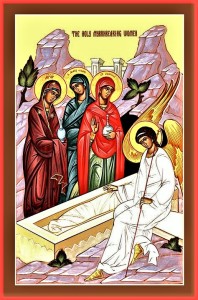Sunday of the Myrrh-bearing Women – Metropolitan of Strumica Nahum
Somewhere, someone has nicely said that the closer we get to Golgotha, following Christ faithfully, the less people (spiritual children, friends) we see around us. It is not surprising. We also know from the Gospel that the same thing first happened to our Lord Jesus Christ.
There is an exception to this rule. That is the myrrh-bearing women. What we should give emphasis to, having in mind their hagiography, as the most characteristic thing of their overall struggle in the service of the God-Man Christ?
That unwavering and constant following of Christ, no matter what happens to Him, no matter the possible difficulties, and no matter what the consequences may be for them, themselves.
This is that personal attitude towards God that is characteristic of the children of God, as opposed to that of the slaves and the hired workers. The relationship of giving and the relationship without benefit.
But what else do I want to emphasise, which is something really special and amazing to me, about myrrh-bearing women?
In that period of the activity and preaching of the God-Man Christ, when He miraculously heals people that are sick even from the most severe diseases, and when He even raises the dead, when He miraculously feeds thousands of hungry people, who gather around Him and when as an earthly king glorify Him while welcoming Him in Jerusalem, the service and presence of myrrh-bearing women is almost imperceptible; but in the period when His sufferings begin, their faithfulness and their presence immediately emerge. Miraculous humility and miraculous love …
The Myrrh-bearing women show us the way. Christ Himself sets them as an example.
The difference in the greeting confirms what has been said:
It is one thing to greet someone with the words “rejoice”, like Christ greeted – Theotokos and the myrrh-bearing women, after the Resurrection, and it is another to greet someone with the words “peace be upon you”, like Christ greeted – the Apostles. With “rejoice” the unwavering are greeted, and with “peace be upon you” the hesitant.
What does the example of Theotokos and the myrrh-bearing women remind us of? We all know that at the beginning of our Orthodox spiritual life, God’s grace openly and clearly supports us in our struggle, and then every struggle seems easy to us. And we all obtained the experience that the grace then hides from us for short periods, and everything seems very difficult to us.
It is important to us that God gives us these periods of hiding of the grace of God for our spiritual growth and perfection. Every time we abandon the struggle in the period when grace is hidden, we act as hired workers and merchants, not as children; and we fall.
In order to achieve continuity in our struggle, our will and perseverance help us the most. So, we should force ourselves through our firmly expressed will to continue with the appropriate struggle even in the period when the grace is hidden (or acts secretly in us).
The continuity of the struggle in a longer and difficult period of hiding of the grace is a sign that the transition from the first stage (purification of the heart) to the second stage of the spiritual development (enlightenment of the mind) is very close, just like the corresponding gift which belongs to the children of God. – to the true and lawful heirs of the Tradition of their Heavenly Father.
Theotokos, together with the myrrh-bearing women, suffered the most and to the end under the Cross, but that is why they were the first to hear the news of Christ’s resurrection and they were the first to touch the Risen God-Man Christ.
Most Holy Theotokos together with the myrrh-bearing women, save us!
Metropolitan of Strumica Naum
(15.05.2021 15:49)

